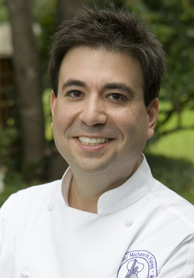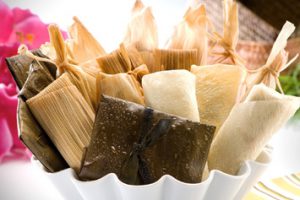
By Chef Michael Flores
As a child, the first time I saw tamales on the menu of a Mexican restaurant, in September; I laughed! It wasn’t December; they had no place being on that menu. Tamales are for Christmas and New Year’s Eve.
At least that was my family experience. Pero tamales in September? Nombre. Get out of here. If my grandmothers saw the menu they’d say, “están locos,” “they’re crazy!”
I remember sitting at my grandmothers’ tables mesmerized by “La Doña de la Cocina” and her brigade of Tias y primas making dozens upon dozens of tamales. I desperately wanted to join, but I was a boy. We were supposed to be hunting out on the ranch for the filling, or relaxing on one of the sofas watching whatever sports game was on.
The art of making a tamale is not a simple, one-day process. Fillings have to be prepared. (Both grandmothers made pork, bean, chicken with jalapeños, and sweet tamales.) Husks have to be soaked and masa has to be made. Spreading the masa onto the husks is the next step followed by adding the stuffing, wrapping the “package,” and then steaming them until they are cooked. Which reminds me, the steamer has to be prepared by filling it with just enough water, and lining the pan with cornhusks.
Granny (my mother’s mother) used a large pot with a little pie tin at the bottom turned upside down. She layered the uncooked tamales in the shape of a teepee. Uelita (my father’s mother) used an electric roaster, and layered them at an angle también. Next came the cooking, or steaming.
I remember that little by little I started joining in. First at my mom’s mother’s house—that side of the family was smaller and easier to infiltrate! Once I had mastered the art taught to me by Granny, I moved on to Uelita’s. With speed and agility, I got started and impressed everyone around the table.
By the way, a gathering of people who have gotten together simply to make tamales is called a “Tamalada.” Gossip is definitely a must!
Eventually I realized that although I knew how the assembly line worked I did not actually know how to make tamales. How did you make the masa, what spices went into what, ay carajo, I thought. This is stupid, unless it was all done for me, I could not make tamales. Something had to be done.
I had the foresight to know that my grandmothers would not be around forever, so I started spending time with each one of them learning their culinary arts and secrets, including the making (not assembling) of tamales. Granny taught me first and then Uelita.
The result of my training is a simply delicious tamale (Tex-Mex style) where I combine both grandmothers’ recipes to create my own, Son deliciosos, of course as a chef I’ve created many different tamales with various “wrappers.” I know you will enjoy mastering them and having your own Tamalada.
Before I forget, there is one very last step of this tamale process: Making the sauce, you are going to serve with your freshly homemade tamales. Everyone has one. Mine is a delicious salsa cocida with tomatoes, chile morita, and lots of onion, garlic, and comino. And if making the tamales is enough work for now, many people, including my family, simply drizzle on ketchup and hot sauce (like Cholula). ¡Buen Provecho!

At one point in my early career I was hired to open and operate a Cooking School and Gourmet Store. During this time I met Cynthia Guido, a great lady and fabulous cook. She came to work with me and together we had some great times developing recipes, testing them, and then teaching them. For one class we decided to have a tamalada, an event where everyone gathers to make tamales—and gossip, of course! Here is a tamal recipe that we created. I will admit that this recipe is involved, but when you take the time to prepare them you will discover that they are ¡delicioso!
Filling:
3 cups chicken breast, boiled and shredded
1 cup pork shoulder or butt, boiled and shredded
4 cups cooking liquids reserved from chicken and pork
4 chiles anchos
3 chiles pasillas
2 medium tomatoes
2 large tomatillos
1/4 cup raisins
1/4 cup slivered almonds
1 tablespoon sesame seeds
1 teaspoon oregano
6 garlic cloves
1 medium white onion
juice of ½ a lemon
½ teaspoon cinnamon
salt and pepper to taste
½ cup corn oil
pitted prunes (4 halves per tamal)
Pitted green olives (3 halves per tamal)
Masa:
I suggest using your favorite masa recipe (if you have one) or using the Maseca brand mix for tortillas [do not use the Maseca for tamale mix] (found at your local grocery store in the section where you find flour and corn meal) and follow the directions on the package.
Directions:
In a large skillet, lightly toast the sesame seeds. Remove them and set aside. Add a tablespoon of corn oil to the skillet and toast almonds until pale gold in color; next add raisins, oregano, cinnamon, salt and pepper, and toast for about 3 minutes, being careful not to burn. Remove and set aside.
In same skillet, add another tablespoon of corn oil, briefly fry the cleaned and seeded chiles, remove them to a bowl and cover with hot water, allow to soften.
In blender or food processor, coarsely grind sesame seeds, almonds and raisin mixture. Remove. Puree rehydrated chiles with a bit of the liquid to make a paste. Remove and set aside. Now puree tomatoes, tomatillos, garlic, and onion; fry mixture briefly in 1 or 2 tablespoons of corn oil.
In clean skillet with 2 tablespoons corn oil fry ground nut and seed mixture for 2-3 minutes. Add the chile paste and the previously cooked tomato-onion mixture along with approximately 1 cup of reserved broth from meats. Allow this mixture to simmer until thickened, adjust seasonings.
In this tamal the ingredients all meet on the banana leaf — on a 9-inch square of banana leaf spread approximately 1/3 cup of prepared masa. Place shredded chicken and pork in a vertical line over masa. Spoon approximately 1 tablespoon sauce over meats. Arrange prunes and olives over and fold to form tamal. Arrange the filled tamales in a steamer and steam until done, approximately 45 minutes to an hour.
Over his 20 years as an acclaimed chef, television personality, author, and owner of a specialty foods company, Michael Flores has honed a passion for Texas cuisine inspired by the vast selection of high quality, locally produced foods available. Despite his formal training at the Culinary Institute of America in New York, Michael focuses on providing simple solutions for encouraging families to get back to the table. For recipes and more information, please visit www.cookwithmichael.com.